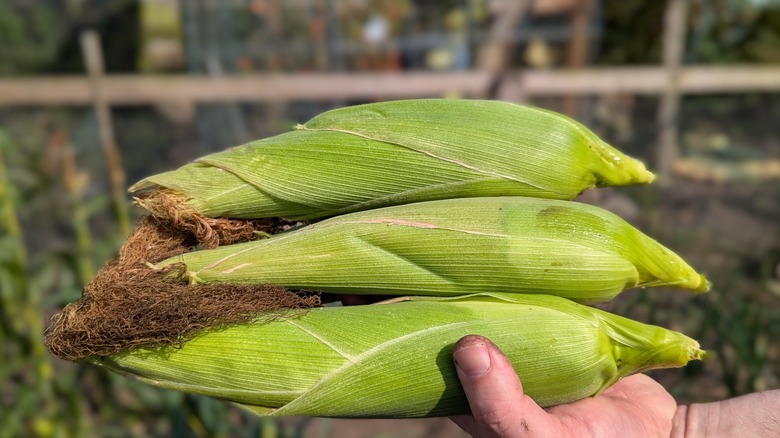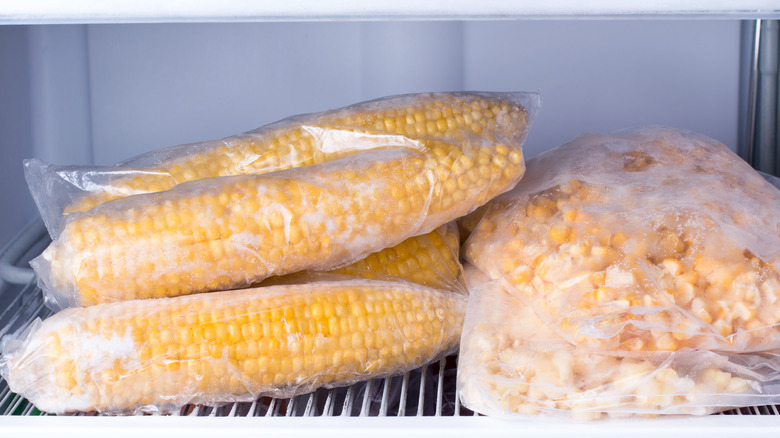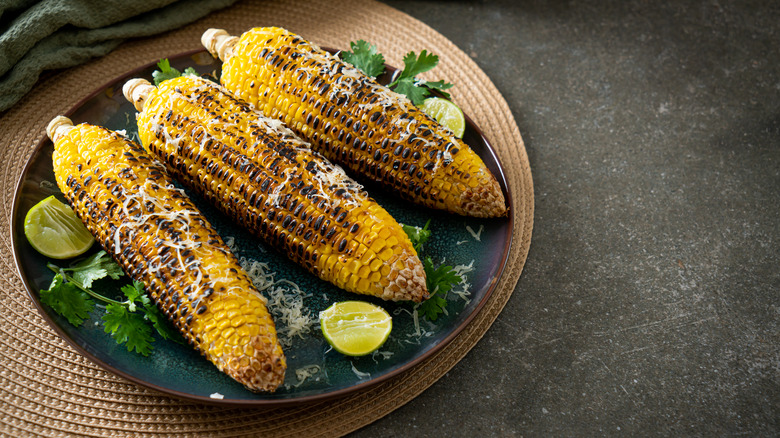The Best Way To Store Corn On The Cob (And How Long It Lasts In The Fridge)
Whether you consider it a grain, fruit, or vegetable, corn is one of the most versatile ingredients to grace plates as a side dish, tossed with other vegetables for a refreshing salad, or made into elote for a tasty snack. And when it comes to ranking America's favorite vegetables, it features way up there with the likes of broccoli, spinach, and green beans. So it's no wonder many cooks stockpile this starchy vegetable to ensure they have a few on hand when the corn-craving strikes. But how do you keep them fresh before you're ready to cook them? The trick is refrigeration.
When it comes to raw, fresh corn ears, the biggest concern is that, with time, they tend to dry up and their appealing natural sugars convert into starch, hence losing their sweet flavor. To slow down this inevitable deterioration process, that's where your fridge comes in.
First, select the best and freshest corn ears for refrigeration — green, tightly wrapped husks and moist silk threads are what you should look for. Keep the husks on and only remove a few of the top-most layers if they're too bulky to fit in the refrigerator. These leaves help preserve the moisture in the kernels underneath. Next, loosely pack the ears in a plastic bag and store them in the crisper drawer. Do this, and your corn ears will remain fresh for about two days. But if you need this veggie to last longer in the fridge, try freezing instead.
Freeze fresh corn for longer storage
If you're not planning on using your fresh corn any time soon, it's safer to freeze it since it'll last for up to a year. For whole corn on the cob, first, shuck the corn and remove the silk threads from the ears. Bring a pot of water to boil, then drop the ears inside, leaving them to blanch for six to 10 minutes. Remove the corn from the boiling water using tongs, and transfer the ears to an ice bath to stop the cooking process. Next, lay them on a rack or pat them with paper towels to dry. Once cool and completely dry, transfer to a plastic freezer bag, remove the air from inside, seal them, and pop them in the freezer.
If you want to store just the kernels without the cobs, first follow the blanching process above. Once the corn ears are cool and dry, take one at a time and place them upright on a chopping board. Cut off the kernels by running a sharp knife from the top to the bottom of each ear to cut the kernels at the base. Pack the kernels in a plastic freezer bag with air removed. and store in the freezer.
Blanching the corn before freezing helps to preserve the texture, color, and flavor of the corn. However, this step isn't mandatory, so you can omit it and follow the rest of the steps to freeze your corn on the cob or the corn kernels.
How to store cooked corn
If you've already cooked the corn and now have leftovers, whether grilled corn on the cob, fried corn, corn chowder, or any other corn-based dish, you can also refrigerate it for later use. Simply let the cooked corn cool first, then put it in an airtight container or a resealable plastic bag before stashing it in the fridge. Like most other leftover foods, this corn can last for three to four days. For corn on the cob, feel free to first cut off the kernels from the cob before packing if you plan on making a different dish later.
Alternatively, freeze the corn if you're aiming for a longer storage period. First, transfer the corn into a freezer-safe container that's airtight or a freezer bag and remove all the air before sealing. Label the container or bag with the item and the date then put in the freezer. These frozen leftovers can stored safely indefinitely, however, for the best quality, it's best to use them within three to four months. Once you're ready, thaw and then reheat the corn before eating.


